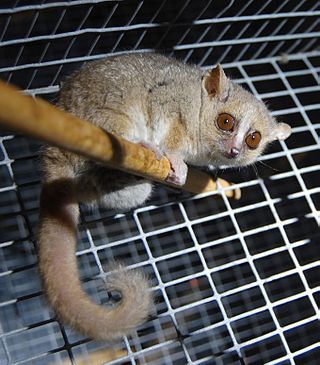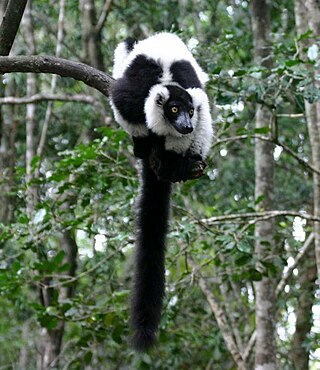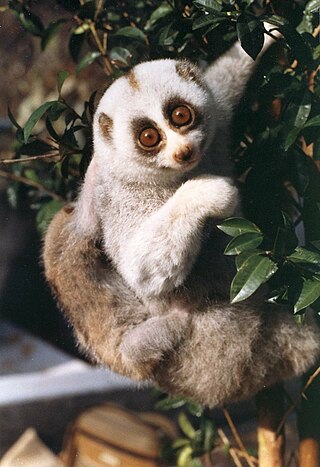
The Cheirogaleidae are the family of strepsirrhine primates containing the various dwarf and mouse lemurs. Like all other lemurs, cheirogaleids live exclusively on the island of Madagascar.

The aye-aye is a long-fingered lemur, a strepsirrhine primate native to Madagascar with rodent-like teeth that perpetually grow and a special thin middle finger that they can use to catch grubs and larvae out of tree trunks.

Lesser bushbabies, or lesser galagos, are strepsirrhine primates of the genus Galago. They are classified, along with the other bushbaby and galago genera in the family Galagidae. They are probably the most numerous primate in Africa, and can be found in every large forest on the continent, inhabiting forested areas, savannas, riverine bush and open woodlands.

The woolly lemurs, also known as avahis or woolly indris, are nine species of strepsirrhine primates in the genus Avahi. Like all other lemurs, they live only on the island of Madagascar.

Lemurs are wet-nosed primates of the superfamily Lemuroidea, divided into 8 families and consisting of 15 genera and around 100 existing species. They are endemic to the island of Madagascar. Most existing lemurs are small, have a pointed snout, large eyes, and a long tail. They chiefly live in trees and are active at night.

The gray mouse lemur, grey mouse lemur or lesser mouse lemur is a small lemur, a type of strepsirrhine primate, found only on the island of Madagascar. Weighing 58 to 67 grams, it is the largest of the mouse lemurs, a group that includes the smallest primates in the world. The species is named for its mouse-like size and coloration and is known locally as tsidy, koitsiky, titilivaha, pondiky, and vakiandry. The gray mouse lemur and all other mouse lemurs are considered cryptic species, as they are nearly indistinguishable from each other by appearance. For this reason, the gray mouse lemur was considered the only mouse lemur species for decades until more recent studies began to distinguish between the species.

The ruffed lemurs of the genus Varecia are strepsirrhine primates and are the largest extant lemurs within the family Lemuridae. Like all living lemurs, they are found only on the island of Madagascar. Formerly considered to be a monotypic genus, two species are now recognized: the black-and-white ruffed lemur, with its three subspecies, and the red ruffed lemur.

The giant mouse lemurs are members of the strepsirrhine primate genus Mirza. Two species have been formally described; the northern giant mouse lemur and Coquerel's giant mouse lemur. Like all other lemurs, they are native to Madagascar, where they are found in the western dry deciduous forests and further to the north in the Sambirano Valley and Sahamalaza Peninsula. First described in 1867 as a single species, they were grouped with mouse lemurs and dwarf lemurs. In 1870, British zoologist John Edward Gray assigned them to their own genus, Mirza. The classification was not widely accepted until the 1990s, which followed the revival of the genus by American paleoanthropologist Ian Tattersall in 1982. In 2005, the northern population was declared a new species, and in 2010, the World Wide Fund for Nature announced that a southwestern population might also be a new species.

The red ruffed lemur is one of two species in the genus Varecia, the ruffed lemurs; the other is the black-and-white ruffed lemur. Like all lemurs, it is native to Madagascar. It occurs only in the rainforests of Masoala, in the northeast of the island. It is one of the largest primates of Madagascar with a body length of 53 cm, a tail length of 60 cm and a weight of 3.3–3.6 kg. Its soft, thick fur is red and black in color and sports a buff or cream colored spot at the nape, but a few are known to have a white or pink patch on the back of the limbs or digits and a ring on the base of the tail in a similar color.

Madame Berthe's mouse lemur or Berthe's mouse lemur is the smallest of the mouse lemurs and the smallest primate in the world; the average body length is 9.2 cm (3.6 in) and seasonal weight is around 30 g (1.1 oz). Microcebus berthae is one of many species of Malagasy lemurs that came about through extensive speciation, caused by unknown environmental mechanisms and conditions.

The Amber Mountain fork-marked lemur, also known as the Montagne d'Ambre fork-crowned lemur or Tanta, is a small primate, and like the other lemurs, can only be found on the island of Madagascar. The species is named after the Amber Mountain National Park where they are found.

The pale fork-marked lemur, or western fork-marked lemur, is a species of lemur known from western Madagascar; south of the Fiherenana River to the region of Soalala. It is said to be the smallest fork-marked species. It is listed on CITES Appendix I as Endangered. They are about 9–11 in (230–280 mm) long from head to rump and their tail adds another 11–15 in (280–380 mm). Pale fork-marked lemur's weigh around 11–18 oz (310–510 g)

The Bengal slow loris or northern slow loris is a strepsirrhine primate and a species of slow loris native to the Indian subcontinent and Indochina. Its geographic range is larger than that of any other slow loris species. Considered a subspecies of the Sunda slow loris (N. coucang) until 2001, phylogenetic analysis suggests that the Bengal slow loris is most closely related to the Sunda slow loris. However, some individuals in both species have mitochondrial DNA sequences that resemble those of the other species, due to introgressive hybridization. It is the largest species of slow loris, measuring 26 to 38 cm from head to tail and weighing between 1 and 2.1 kg. Like other slow lorises, it has a wet nose (rhinarium), a round head, flat face, large eyes, small ears, a vestigial tail, and dense, woolly fur. The toxin it secretes from its brachial gland differs chemically from that of other slow loris species and may be used to communicate information about sex, age, health, and social status.

The black-tailed tree rat, also called black-tailed acacia rat or black-tailed thallomys,, is a species of rodent in the family Muridae. It is found in Angola, Botswana, Namibia and South Africa, where its natural habitat is subtropical or tropical dry shrubland. It is both nocturnal and arboreal and makes bulky nests in the trees, often acacias, where it feeds on leaves and buds.

The southern needle-clawed bushbaby is a species of strepsirrhine primate in the family Galagidae. Found in Cameroon, Central African Republic, Republic of the Congo, and possibly Democratic Republic of the Congo, its natural habitat is tropical moist forests. While the species is not threatened or endangered, some local populations may be threatened by habitat destruction.

Pariente's fork-marked lemur, or the Sambirano fork-marked lemur, is a species of lemur endemic to the Sambirano region of north-western Madagascar. This lemur has light brown to gray upperparts, a prominent facial fork and dorsal stripe that runs from the tail's tip to the point where it splits on the lemur's head to rejoin at the nose, and a white-tipped tail. It is found in lowland and mid-altitude humid forests and is nocturnal. It is an omnivore, eating tree gum, sap, bud exudes, insects and larvae. It sleeps in nests that have been abandoned by other lemurs, particularly Coquerel's giant mouse lemur. This species is relatively unknown, though it is threatened by habitat destruction. It was previously considered a subspecies of the Masoala fork-marked lemur. It is listed on CITES Appendix I.

Fork-marked lemurs or fork-crowned lemurs are strepsirrhine primates; the four species comprise the genus Phaner. Like all lemurs, they are native to Madagascar, where they are found only in the west, north, and east sides of the island. They are named for the two black stripes which run up from the eyes, converge on the top of the head, and run down the back as a single black stripe. They were originally placed in the genus Lemur in 1839, later moved between the genera Cheirogaleus and Microcebus, and given their own genus in 1870 by John Edward Gray. Only one species was recognized, until three subspecies described in 1991 were promoted to species status in 2001. New species may yet be identified, particularly in northeast Madagascar.

Tsimanampetsotsa National Park also spelt Tsimanampetsotse, and known as Tsimanampetsotsa Nature Reserve is a 432 km2 national park on the south-west coast of Madagascar in the region Atsimo-Andrefana. The park is 90 kilometres (56 mi) south of Toliara and 950 kilometres (590 mi) south of the capital, Antananarivo. Route Nationales (RN) 10 to Faux Cap passes the park and the nearest airport is at Toliara. The national park contains and is named after Lake Tsimanampetsotsa.

The Sahamalaza sportive lemur is a species of sportive lemur endemic to northern Madagascar.
A gummivore is an omnivorous animal whose diet consists primarily of the gums and saps of trees and bugs for protein. Notable gummivores include arboreal, terrestrial primates like certain marmosets and lemurs. These animals that live off of the injuries of trees live from about 8m off of the ground up to the canopies. The feeding habit of gummivores is gummivory.




















